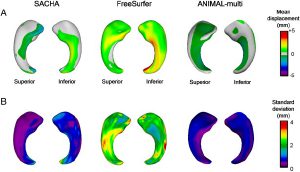Abstract
In drug-resistant temporal lobe epilepsy (TLE), detecting hippocampal atrophy on MRI is important as it allows defining the surgical target. The performance of automatic segmentation in TLE has so far been considered unsatisfactory. In addition to atrophy, about 40% of patients present with developmental abnormalities (referred to as malrotation) characterized by atypical morphologies of the hippocampus and collateral sulcus. Our purpose was to evaluate the impact of malrotation and atrophy on the performance of three state-of-the-art automated algorithms. We segmented the hippocampus in 66 patients and 35 sex- and age-matched healthy subjects using a region-growing algorithm constrained by anatomical priors (SACHA), a freely available atlas-based software (FreeSurfer) and a multi-atlas approach (ANIMAL-multi). To quantify malrotation, we generated 3D models from manual hippocampal labels and automatically extracted collateral sulci. The accuracy of automated techniques was evaluated relative to manual labeling using the Dice similarity index and surface-based shape mapping, for which we computed vertex-wise displacement vectors between automated and manual segmentations. We then correlated segmentation accuracy with malrotation features and atrophy. ANIMAL-multi demonstrated similar accuracy in patients and healthy controls (p > 0.1), whereas SACHA and FreeSurfer were less accurate in patients (p < 0.05). Surface-based analysis of contour accuracy revealed that SACHA over-estimated the lateral border of malrotated hippocampi (r = 0.61; p < 0.0001), but performed well in the presence of atrophy (|r |< 0.34; p > 0.2). Conversely, FreeSurfer and ANIMAL-multi were affected by both malrotation (FreeSurfer: r = 0.57; p = 0.02, ANIMAL-multi: r = 0.50; p = 0.05) and atrophy (FreeSurfer: r = 0.78, p < 0.0001, ANIMAL-multi: r = 0.61; p < 0.0001). Compared to manual volumetry, automated procedures underestimated the magnitude of atrophy (Cohen's d: manual: 1.68; ANIMAL-multi: 1.11; SACHA: 1.10; FreeSurfer: 0.90, p < 0.0001). In addition, they tended to lateralize the seizure focus less accurately in the presence of malrotation (manual: 64%; ANIMAL-multi: 55%, p = 0.4; SACHA: 50%, p = 0.1; FreeSurfer: 41%, p = 0.05). Hippocampal developmental anomalies and atrophy had a negative impact on the segmentation performance of three state-of-the-art automated methods. These shape variants should be taken into account when designing segmentation algorithms.

